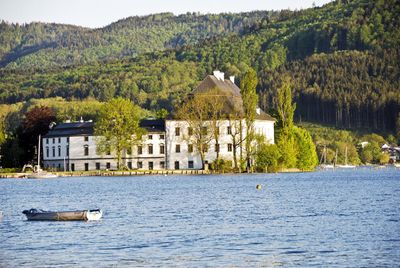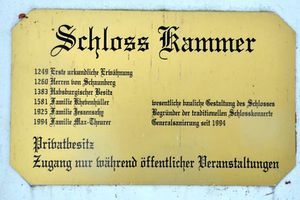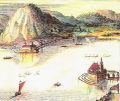Kammer Castle: Unterschied zwischen den Versionen
Keine Bearbeitungszusammenfassung |
Admin (Diskussion | Beiträge) Keine Bearbeitungszusammenfassung |
||
| Zeile 1: | Zeile 1: | ||
[[Bild:Schloss Kammer DSC 6124A.JPG|400px|thumb| | [[Bild:Schloss Kammer DSC 6124A.JPG|400px|thumb|Kammer Castle in springtime]] | ||
Today the castle is situated on a peninsula, originally on an island in the northern [[Attersee (See)|Attersee]], and is a massive, rectangular, three-storey building with two low side wings surrounding a courtyard. | |||
== | == History == | ||
With the order of the Schaunberger as voires appeared 1249 with Haidfalk | With the order of the [[Schaunberger]] as voires appeared 1249 with Haidfalk von Chamer, (Hæidfolcho de Chamer) for the first time the name Kammer. | ||
1260 | 1260 the Kammer Castle is mentioned for the first time. This "Veste Camer im Adersee", the later Kammer Castle, was expanded on a small island in the lake by the Schaunberger to the administrative center of the [[Attergau]]. | ||
In the "Schaunberger Fehde" between the Habsburg Duke Albrecht III and Count Heinrich von Schaunberg, Reinprecht II of Wallsee conquered the castle in 1380. On occasion of the peace treaty of 1383 the Schaunberger were forced to sell Kammer to the duke. | |||
Attersee/Kogl, Frankenburg and Kammer were now pledged | Attersee/Kogl, Frankenburg and Kammer were now pledged. In 1383, the land chief of Upper Austria, Heinrich IV von Wallsee, was the first landlord. 1483 the Jörger followed and from 1499 the gentlemen of Polheim. | ||
In 1540, the rich Hanns Hofmann, patron of Grüenpüchel and Strechau, bought Kammer as a free property. In 1570 the Habsburgs bought back Kammer. In order to cover debt, Emperor Rudolf II finally had to sell | In 1540, the rich Hanns Hofmann, patron of Grüenpüchel and Strechau, bought Kammer as a free property. In 1570 the Habsburgs bought back Kammer. In order to cover debt, Emperor Rudolf II finally had to sell to his chamberlain and ambassador in Spain, Hans Freiherr von Khevenhüller. He was raised to a count in 1593. His three dominions, Frankenburg, Kogl and Kammer, now constituted the county of Frankenburg. | ||
The | The old castle, which could only be reached by way of a drawbridge, was considerably enlarged between 1622 and 1649 (construction of the Rittersaal). | ||
In 1710 the | In 1710 the old castle, under direction of the baroque master Michael Prunner from Linz, was converted into a modern castle. Prunner also planned the ensemble of economic buildings clustered around a round square. With more than 10,000 Gulden income, Kammer was a considerable economic factor. In 1750 674 subjects belonged to the ruling Kammer. From the originally four archways, two arches had to be demolished due to the increasing car traffic in the 20th century (North Gate 1938, South Gate 1971). | ||
Also noteworthy is the chapel, whose altar was created by the Baroque artist Franz Josef Holzinger. | Also noteworthy is the chapel, whose altar was created by the Baroque artist [[Franz Josef Holzinger]]. | ||
Until 1848 | Until 1848 Kammer Castle was the seat of a regional court. In 1837 the last public execution took place there. The murderer who had been condemned to death was hanged at nine o'clock in the morning, and the corpse was taken from the gallows at 6 o'clock in the evening. | ||
Until 1903, the Khevenhüller family remained | Until 1903, the Khevenhüller family remained owner of the castle. Due to financial reasons, Ida, the daughter of the last Upper Austrian Khevenhüller, had to hand over the property to the Oberösterreichische Landeshypothekenanstalt. | ||
Kammer Castle was now a bourgeois property. In 1925 the castle came to the Jeszensky family and in 1994 to the Max-Theurer family. | |||
At the beginning of the 20th century Gustav Klimt presented the castle and its surroundings in several paintings, | At the beginning of the 20th century Gustav Klimt presented the castle and its surroundings in several paintings, for example in 1910 in a 110x110 cm oil painting, which today hangs in the Austrian Gallery Belvedere in Vienna. Also the Lime Avenue, which leads from the former economic buildings to the castle, was represented by the art nouveau artist in one of his famous Attersee pictures. Since 2012 the [[Gustav Klimt Zentrum]] is located at the Lime Avenue, painted by the artist. | ||
== The best known patrons of Kammer Castle == | |||
[[Bild:SchlossKammer DSC 0777 20090221 1165 Atternet.JPG|300px|thumb|center|The best known patrons of Kammer Castle]] | |||
== Adress == | |||
== | |||
:Am Attersee | :Am Attersee | ||
:4861 [[Schörfling am Attersee]] | :4861 [[Schörfling am Attersee]] | ||
== | == Plan == | ||
Nord: +47° 56' 46.19" / Ost +13° 35' 28.78" [http://maps.google.at/maps/ms?hl=de&ie=UTF8&msa=0&ll=47.946548,13.591933&spn=0.016874,0.039482&t=h&z=15&msid=106467774100330086507.00047ba810cae3b77623d Google Maps - Schloss Kammer] | Nord: +47° 56' 46.19" / Ost +13° 35' 28.78" [http://maps.google.at/maps/ms?hl=de&ie=UTF8&msa=0&ll=47.946548,13.591933&spn=0.016874,0.039482&t=h&z=15&msid=106467774100330086507.00047ba810cae3b77623d Google Maps - Schloss Kammer] | ||
== | == Opening Times == | ||
The Kammer Castle is a private property and can not be visited. | |||
== | == Pictures == | ||
<gallery> | <gallery> | ||
Bild:Schloss Kammer 022.JPG | Bild:Schloss Kammer 022.JPG | ||
| Zeile 69: | Zeile 45: | ||
Bild:Schloss Kammer Maerz2004 021.JPG | Bild:Schloss Kammer Maerz2004 021.JPG | ||
Bild:Schloss Kammer im Winter Jan2005- 206.JPG | Bild:Schloss Kammer im Winter Jan2005- 206.JPG | ||
Datei:Park am Atterseeufer in Kammer.jpg | Datei:Park am Atterseeufer in Kammer.jpg | ||
Bild:SchlossKammer P8220022.JPG | Bild:SchlossKammer P8220022.JPG | ||
Bild:SchlossKammer JUNI05-2 116.JPG | Bild:SchlossKammer JUNI05-2 116.JPG | ||
| Zeile 83: | Zeile 59: | ||
</gallery> | </gallery> | ||
=== | === Aerial Views === | ||
<gallery> | <gallery> | ||
Bild:SchKammerGand.jpg | Bild:SchKammerGand.jpg | ||
| Zeile 92: | Zeile 68: | ||
</gallery> | </gallery> | ||
=== | === Old Postcards and Drawings === | ||
show Kammer Castle in past times: | |||
<gallery> | <gallery> | ||
Bild:SchlossKammer001 Scan20002.JPG| | Bild:SchlossKammer001 Scan20002.JPG|Old postcard | ||
Bild:HD_1622.jpg| | Bild:HD_1622.jpg|Kammer Castle 1622 - Drawing by Hans Dickinger | ||
Bild:Mayer Merian Litzl.jpg| | Bild:Mayer Merian Litzl.jpg|Kammer Castle and Litzlberg Castle - Archive [[August Mayer]] | ||
Bild:AlteLandkAttersee.jpg| | Bild:AlteLandkAttersee.jpg|Old Card - Attergau aus OÖ.-Karte von G.M. Vischer 1667 | ||
</gallery> | </gallery> | ||
Version vom 6. Mai 2017, 19:18 Uhr
Today the castle is situated on a peninsula, originally on an island in the northern Attersee, and is a massive, rectangular, three-storey building with two low side wings surrounding a courtyard.
History
With the order of the Schaunberger as voires appeared 1249 with Haidfalk von Chamer, (Hæidfolcho de Chamer) for the first time the name Kammer.
1260 the Kammer Castle is mentioned for the first time. This "Veste Camer im Adersee", the later Kammer Castle, was expanded on a small island in the lake by the Schaunberger to the administrative center of the Attergau. In the "Schaunberger Fehde" between the Habsburg Duke Albrecht III and Count Heinrich von Schaunberg, Reinprecht II of Wallsee conquered the castle in 1380. On occasion of the peace treaty of 1383 the Schaunberger were forced to sell Kammer to the duke.
Attersee/Kogl, Frankenburg and Kammer were now pledged. In 1383, the land chief of Upper Austria, Heinrich IV von Wallsee, was the first landlord. 1483 the Jörger followed and from 1499 the gentlemen of Polheim.
In 1540, the rich Hanns Hofmann, patron of Grüenpüchel and Strechau, bought Kammer as a free property. In 1570 the Habsburgs bought back Kammer. In order to cover debt, Emperor Rudolf II finally had to sell to his chamberlain and ambassador in Spain, Hans Freiherr von Khevenhüller. He was raised to a count in 1593. His three dominions, Frankenburg, Kogl and Kammer, now constituted the county of Frankenburg.
The old castle, which could only be reached by way of a drawbridge, was considerably enlarged between 1622 and 1649 (construction of the Rittersaal).
In 1710 the old castle, under direction of the baroque master Michael Prunner from Linz, was converted into a modern castle. Prunner also planned the ensemble of economic buildings clustered around a round square. With more than 10,000 Gulden income, Kammer was a considerable economic factor. In 1750 674 subjects belonged to the ruling Kammer. From the originally four archways, two arches had to be demolished due to the increasing car traffic in the 20th century (North Gate 1938, South Gate 1971).
Also noteworthy is the chapel, whose altar was created by the Baroque artist Franz Josef Holzinger.
Until 1848 Kammer Castle was the seat of a regional court. In 1837 the last public execution took place there. The murderer who had been condemned to death was hanged at nine o'clock in the morning, and the corpse was taken from the gallows at 6 o'clock in the evening.
Until 1903, the Khevenhüller family remained owner of the castle. Due to financial reasons, Ida, the daughter of the last Upper Austrian Khevenhüller, had to hand over the property to the Oberösterreichische Landeshypothekenanstalt.
Kammer Castle was now a bourgeois property. In 1925 the castle came to the Jeszensky family and in 1994 to the Max-Theurer family.
At the beginning of the 20th century Gustav Klimt presented the castle and its surroundings in several paintings, for example in 1910 in a 110x110 cm oil painting, which today hangs in the Austrian Gallery Belvedere in Vienna. Also the Lime Avenue, which leads from the former economic buildings to the castle, was represented by the art nouveau artist in one of his famous Attersee pictures. Since 2012 the Gustav Klimt Zentrum is located at the Lime Avenue, painted by the artist.
The best known patrons of Kammer Castle
Adress
- Am Attersee
- 4861 Schörfling am Attersee
Plan
Nord: +47° 56' 46.19" / Ost +13° 35' 28.78" Google Maps - Schloss Kammer
Opening Times
The Kammer Castle is a private property and can not be visited.
Pictures
Aerial Views
Old Postcards and Drawings
show Kammer Castle in past times:
Kammer Castle and Litzlberg Castle - Archive August Mayer


























